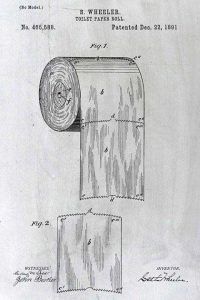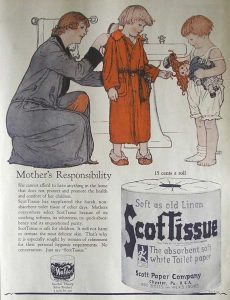Small Home Gazette, Spring 2020
The Unmentionable Becomes an American Staple
 We take toilet paper for granted. But in the late 1800s, many Americans without indoor plumbing were using pages of telephone books or the Sears Roebuck catalog because the paper was a soft, absorbent newsprint style.
We take toilet paper for granted. But in the late 1800s, many Americans without indoor plumbing were using pages of telephone books or the Sears Roebuck catalog because the paper was a soft, absorbent newsprint style.
 The first products designed specifically to wipe one’s tushy were aloe-infused sheets of hemp, dispensed from boxes. Reputed to help hemorrhoids, New Yorker Joseph Gayetty was so proud of his therapeutic bathroom paper—made from 1857 through the late 1920s—that his name was printed on each sheet.
The first products designed specifically to wipe one’s tushy were aloe-infused sheets of hemp, dispensed from boxes. Reputed to help hemorrhoids, New Yorker Joseph Gayetty was so proud of his therapeutic bathroom paper—made from 1857 through the late 1920s—that his name was printed on each sheet.
-
In 1871, Seth Wheeler invented the first rolled and perforated toilet paper.

Patent image for rolled and perforated toilet paper, 1891. One of several held by Seth Wheeler.
- In 1879, the Scott brothers of Philadelphia began marketing to hotels and drugstores, making the paper readily available to people.
- By the early 1900s, indoor plumbing and flush toilets were becoming more common, requiring paper that would not cause clogs or damage to pipes.
- In 1928, the Hoberg Paper Company of Green Bay, Wisconsin, introduced a much softer paper. According to company lore, the feel of the paper plus the ladylike packaging was “charming,” and thus—”Charmin.”
- In the 1930s, Hoberg introduced an economical four-roll pack, which may have helped the company survive the Great Depression.
- In 1935, Northern Paper engineers finally invented a splinter-free toilet paper. Imagine that!
And why is toilet paper usually white? Colors were (and still are) more expensive to produce.

By 1925, Scott Paper Company was the leading toilet paper company in the world. This 1926 ad touts ScotTissue’s softness, whiteness, quick absorbency, and unquestioned purity under the header of “Mother’s Responsibility.” Note the words “Soft as old Linen” on the package wrapper.











